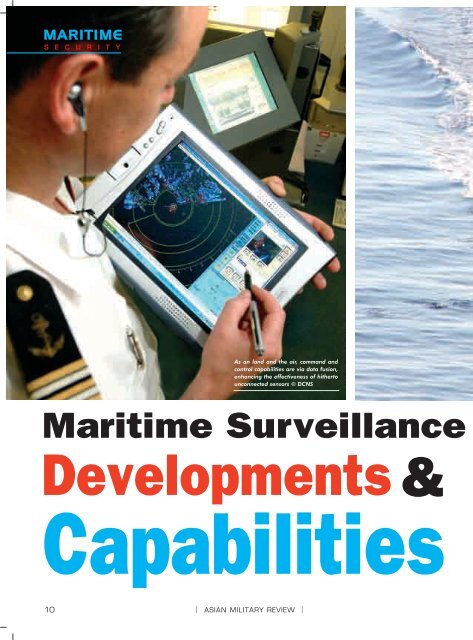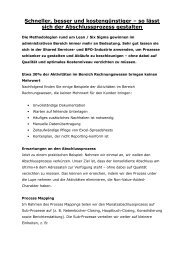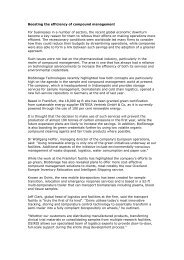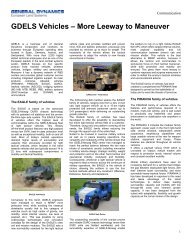Maritime Surveillance and Reco - IQPC.com
Maritime Surveillance and Reco - IQPC.com
Maritime Surveillance and Reco - IQPC.com
You also want an ePaper? Increase the reach of your titles
YUMPU automatically turns print PDFs into web optimized ePapers that Google loves.
MARITIME<br />
S E C U R I T Y<br />
10<br />
As on l<strong>and</strong> <strong>and</strong> the air, <strong>com</strong>m<strong>and</strong> <strong>and</strong><br />
control capabilities are via data fusion,<br />
enhancing the effectiveness of hitherto<br />
unconnected sensors © DCNS<br />
<strong>Maritime</strong> <strong>Surveillance</strong><br />
Developments &<br />
Capabilities<br />
l ASIAN MILITARY REVIEW l
l MARCH/APRIL 2011 l<br />
MARITIME<br />
S E C U R I T Y<br />
Infiltration by terrorists from<br />
the sea is a very real threat<br />
put into perspective by the<br />
2008 Mumbai attacks © AJB<br />
<strong>and</strong> <strong>Reco</strong>nnaissance:<br />
<strong>Maritime</strong> surveillance is not just about the ability to detect <strong>and</strong> cue<br />
supersonic anti-ship missiles in a large scale blue water engagement.<br />
Actually, for the vast majority of countries on the planet it is just<br />
the opposite, focusing instead on economic exclusion zone (EEZ)<br />
surveillance,constabulary tasks <strong>and</strong> counter-terror using systems in the<br />
category of maritime safety <strong>and</strong> security systems, Vessel Traffic<br />
Service (VTS) systems <strong>and</strong> Coastal <strong>Surveillance</strong> Systems. The threats<br />
addressed by maritime safety <strong>and</strong> security have changed quantitatively<br />
<strong>and</strong> qualitatively from the challenges posed by illegal fishing, smuggling<br />
<strong>and</strong> privacy to providing the first line of defence against terrorism<br />
<strong>and</strong> similar threats. The scale of the challenge is considerable,<br />
in 2008, 60,000 ships carried 70 percent of all intercontinental<br />
cargo traffic <strong>and</strong> the figure is growing.<br />
bbyy Adam Baddeley<br />
11
MARITIME<br />
S E C U R I T Y<br />
WHILE <strong>Maritime</strong> Patrol<br />
Aircraft (MPA) receive<br />
the lion’s share of the<br />
attention in maritime surveillance,<br />
it is l<strong>and</strong> based<br />
sensors that do the lions share of the work<br />
increasingly coupled with <strong>com</strong>m<strong>and</strong> <strong>and</strong> control<br />
(C2) systems to achieve their effect.<br />
Turnkey solutions<br />
Countries are avidly seeking turnkey solutions<br />
that bring together new <strong>and</strong> existing<br />
sensors <strong>and</strong> fuse their feeds within a <strong>com</strong>m<strong>and</strong><br />
<strong>and</strong> control networks. France’s<br />
Spationav project, developed by EADS<br />
Sofrelog is the country’s premier maritime<br />
surveillance system integrating sensor feeds<br />
from AIS, airborne <strong>and</strong> l<strong>and</strong> based sensors<br />
allowing the Gendarmerie <strong>and</strong> other bodies<br />
to see that information <strong>and</strong> plan <strong>and</strong> react<br />
accordingly.<br />
Spationav is undergoing regular<br />
improvements. Obzerv Technologies Inc.<br />
recently won a contract from EADS-Sofrelog<br />
for two ARGC-2400 cameras for use in the<br />
Spationav programme. At 6km, the ARGC-<br />
2400 can detect whether the crew of a fast<br />
moving craft are carrying rifles or not,<br />
allowing a rapid response.<br />
Combinations of sensors are<br />
being used in fixed <strong>and</strong> mobile<br />
implementations in the coastal<br />
watch role © AJB<br />
12<br />
EADS Sofrelog’s maritime security package<br />
are in use in a number of harbours in the<br />
region including Pelabuhan Tanjung<br />
Pelepas, Malaysia; Kaohsiung, Taiwan; Goa,<br />
India <strong>and</strong> Dalian, China, In other areas they<br />
provide security management systems for<br />
naval facilities at Brest <strong>and</strong> Toulon <strong>and</strong><br />
other classified locations as well as coastal<br />
monitoring capabilities for the Danish military<br />
<strong>and</strong> a 700km stretch of coastline for the<br />
Finl<strong>and</strong> <strong>Maritime</strong> Authority.<br />
France is continuing to<br />
work to improve solutions<br />
on its Mediterranean<br />
coast with 30 percent of<br />
the world’s maritime traffic<br />
going through its waters<br />
Sofrelog systems are part of the maritime<br />
surveillance <strong>com</strong>ponent to the 2007 €240m<br />
Qatari National Security Shield <strong>and</strong> the<br />
Saudi border surveillance contract covering<br />
the <strong>com</strong>plex environment of the Red Sea<br />
<strong>and</strong> part of the Arabian Gulf. In June 2010,<br />
EADS Sofrelog <strong>and</strong> Atlas <strong>Maritime</strong> Security<br />
announced their intention to form a joint<br />
l ASIAN MILITARY REVIEW l<br />
venture in this area.<br />
France is continuing to work to improve<br />
solutions on its Mediterranean coast with 30<br />
percent of the world’s maritime traffic going<br />
through its waters. In September, the DGA<br />
signed a contract with DCNS to begin the<br />
€7m SISMARIS programme which provides<br />
a <strong>com</strong>pete information systems <strong>and</strong> sensors<br />
co-operative <strong>and</strong> non co-operative tracking<br />
of vessels at day <strong>and</strong> night <strong>and</strong> in all weather<br />
conditions at distances of three to four<br />
days out from ports such as Marseille,<br />
roughly from the Straits of Gibraltar to<br />
Western Libya. Information generated will<br />
be shared with partner organisation including<br />
the Centre de Coordination pour la<br />
Lutte Anti-Drogue en Méditerranée,<br />
Gendarmerie <strong>Maritime</strong> <strong>and</strong> CROSS MED<br />
(Affaires <strong>Maritime</strong>s). The SISMARIS programme<br />
includes the installation of a <strong>com</strong>plete<br />
sensor <strong>and</strong> detection platform with<br />
basic <strong>and</strong> innovative sensors, high frequency<br />
radar <strong>and</strong> for long range detection <strong>and</strong><br />
integrates of airborne platform. DCNS leads<br />
13 partners in the programme.<br />
Indra Sistemas has recently been awarded<br />
a contract by Portugal for its Sistema<br />
Integrado de Vigilância de Com<strong>and</strong>o e<br />
Controlo (SIVICC) programme in a €25
MARITIME<br />
S E C U R I T Y<br />
award which will replace the Elbit sourced<br />
LAOS system <strong>and</strong> will be integrated with<br />
Spain’s Sistema Integrado de Vigilância<br />
Exterior (SIVE). Indra was also selected to<br />
provide Romania’s maritime surveillance<br />
systems cover radar, electro–optic sensors<br />
linking via a bespoke <strong>com</strong>munications network<br />
to the C2 hub based on Constanza.<br />
The Transas Baltic <strong>com</strong>pany in late 2010<br />
has recently signed a contract with<br />
Lithuania to provide a sea surveillance<br />
information system (SSIS) for traffic tracking<br />
<strong>and</strong> logging <strong>and</strong> fisheries surveillance<br />
using sensors along Lithuania coast, which<br />
will use the Transas Navi-Harbor maritime<br />
surveillance <strong>and</strong> information service.<br />
Selex Sistemi Integrati are currently<br />
upgrading Italy’s Dispositivo<br />
Interministeriale di Sorveglianza Marittima<br />
(DISM). In a roughly two year deal to<br />
improve coastal radar coverage, SSI will<br />
supply seven sites with its remotely operated<br />
Radar di Avvistamento per la Scoperta di<br />
Superficie-Costiero IASR (RASSCI). The<br />
RASSCI is an over the horizon radar, building<br />
on the capabilities of the Selex Galileo<br />
Gabbiano T2000C radar.<br />
Countries in the region are benefiting for<br />
outside funding for maritime security. It<br />
was recently announced that the US is<br />
ELTA's EL/M-2107 is a high resolution advanced<br />
miniature radar for security applications<br />
including harbour security © AJB<br />
14 ASIAN MILITARY REVIEW<br />
donating 16 coastal <strong>and</strong> 11 shipboard radar<br />
systems <strong>and</strong> C2 posts to Indonesia to cover<br />
the Straits of Malacca. The two country plan<br />
to extend the network into the Sulawesi Sea<br />
<strong>and</strong> covering roughly 2500km with the overall<br />
system centre will be on the isl<strong>and</strong> of<br />
Batam. Japan has also provided radar to the<br />
support maritime security in the same project.<br />
The work is funded under US DoD<br />
Section 1206 funding to support the international<br />
counter-terrorism work. Malaysia has<br />
received similar capabilities under the same<br />
programme also using US donated radar. In<br />
2008, FLIR Systems announced an order<br />
from Malaysia for 12 ThermoVision 2000<br />
(THV2000) long-range thermal imaging sensor<br />
systems with a range of up to 20 km for<br />
coastal surveillance.<br />
In July 2008, Vietnam’s Marine Police<br />
ordered Swedish Space Corp’s MSS 6000<br />
maritime surveillance system which will<br />
equip CASA C212-400 aircraft for delivery<br />
in 2011. The aircraft will be equipped with<br />
Side-looking airborne radar, still <strong>and</strong> video<br />
cameras <strong>and</strong> other on board sensors in all<br />
weather <strong>and</strong> day <strong>and</strong> night <strong>and</strong> airborne<br />
AIS automatic identification system for<br />
ships linked back to base, using broadb<strong>and</strong><br />
sat<strong>com</strong>.<br />
In 2008, Indra were awarded work under<br />
Spain’s Sea Horse network system, a secure<br />
sat<strong>com</strong> based system linking Spain,<br />
Portugal, Mauritania, Senegal <strong>and</strong> Cape<br />
Verde, focused on information exchange<br />
between the parties on illegal immigration<br />
<strong>and</strong> drug trafficking.<br />
Raytheon’s HFSWR (High-Frequency<br />
Surface Wave Radar) is designed to detect<br />
<strong>and</strong> track ships <strong>and</strong> low-flying aircraft at<br />
beyond 200 nautical mile <strong>and</strong> has been used<br />
by DoD’s CTDPO (Counterdrug Technology<br />
Development Program Office) to deliver<br />
low-cost, all-weather detection capabilities<br />
using polarized HF (High-Frequency) electromagnetic<br />
signals which propagate along<br />
the sea’s surface rather than stopping at the<br />
horizon.<br />
Controp’s Thermal Imaging solutions<br />
have been used in a number of coastal surveillance<br />
solutions. In late 2010, Controp<br />
were awarded a contract to supply their Fox<br />
720 Thermal cameras as a coastal surveillance<br />
subcontract to local prime contractor<br />
in support of India’s Coast Guard. Complete<br />
systems built around Fox variants have also<br />
been supplied for similar programmes with<br />
DANIS systems covering Sydney harbour<br />
since 2010. In Italy, five of Controp’s
Radar solutions such as Cassidian’s TRGS can<br />
detect, small fleeting targets at range on l<strong>and</strong><br />
sea <strong>and</strong> air © Cassidian<br />
CEDAR systems cover the 9km long Gioia<br />
Tauro harbour in a port security system led<br />
by IBM Italia, with two systems covering the<br />
maritime perimeter, the remainder covering<br />
the l<strong>and</strong> facing external fence. The CEDAR<br />
system was also used during the Athens<br />
Olympics for coastal protection. All the<br />
firm’s cameras use Controp’s pioneering<br />
continuous optical zoom technology, allowing<br />
seamless close in investigation of an<br />
object without the operator losing situational<br />
awareness by being able to zoom in <strong>and</strong><br />
out without losing focus.<br />
A key feature of Controp’s surveillance<br />
systems such as CEDAR, DANIS <strong>and</strong> others<br />
including the SPIDER family is the inclusion<br />
of advanced intruder detection software<br />
matched to a panoramic scanning capability.<br />
Once set up, the camera only needs three<br />
<strong>com</strong>plete sweeps taking less than a minute<br />
for long range system over 180 degrees. In a<br />
coastal environment, the software is able to<br />
distinguish between the normal movement<br />
of waves or sea birds <strong>and</strong> pick out swimmers<br />
or rigid inflatables <strong>and</strong> automatically<br />
alert operators to their appearance.<br />
Controp’s latest camera is the Fox 1400,<br />
which equips the SIPDER LR. In recent tests<br />
by Spain’s Guardia Civil, the system was<br />
able to identify a rigid inflatable test subject<br />
at 20km in poor weather at night. The Fox<br />
1400 has a 1.4m focal plane array but this is<br />
‘folded’ using a proprietary method to<br />
reduce the actual length of each camera to<br />
just 40cm.<br />
IAI Elta’s work on coastal surveillance<br />
was prompted by terrorist attacks from the<br />
sea against Israel in the 1970s. In response<br />
the <strong>com</strong>pany developed ELM-2112 family of<br />
multi-mission multi-function radars<br />
designed to detect objects with the range<br />
IAI Elta’s work on coastal<br />
surveillance was prompted<br />
by terrorist attacks<br />
from the sea against Israel<br />
in the 1970s<br />
l MARCH/APRIL 2011 l<br />
MARITIME<br />
S E C U R I T Y<br />
resolution of approximately 1m <strong>and</strong> is capable<br />
of ground <strong>and</strong> sea surveillance <strong>and</strong> supports<br />
simultaneous processing <strong>and</strong> in service<br />
with 15 customers including on Israel’s<br />
coast. The latest version is the V15 which<br />
can detect moving targets at up to 30km.<br />
Co-operation <strong>and</strong> organisation<br />
Organisational efficiency as much as technology<br />
is responsible for ensuring effectiveness<br />
in maritime security. Indonesia <strong>and</strong> Sri<br />
Lanka have both recently activated national<br />
coast guards. International co-operation is<br />
growing too. In July, the South Korean<br />
National Marine Police Agency <strong>and</strong> the<br />
Russian Federal Border Service conducted<br />
an anti-piracy exercise in the Sea of Japan.<br />
Jakarta is reported to be considering coordinated<br />
border patrols with Vietnam along<br />
their <strong>com</strong>mon maritime borders in the South<br />
China Sea. Indonesia has also undertaken<br />
joint patrols with the Philippine Navy along<br />
their <strong>com</strong>mon maritime borders. The India-<br />
Indonesia Co-ordinated Patrol known as<br />
Indido Corpet began on March 5 2010, covering<br />
the seas around the Andaman-Nicobar<br />
15
MARITIME<br />
S E C U R I T Y<br />
The high volumes of cargo required for<br />
international trade require large tracts of the<br />
oceans to be placed under persistent<br />
surveillance © AJB<br />
archipelago, India <strong>and</strong> Weh Isl<strong>and</strong>,<br />
Indonesia. The Indonesians also continue to<br />
patrol with Thail<strong>and</strong>, Singapore <strong>and</strong><br />
Malaysia in the Malacca Straits Sea Patrol.<br />
India <strong>and</strong> the Maldives also recently signed<br />
an agreement with to establish a network of<br />
coastal surveillance radars linking them<br />
with the Indian Coastal Comm<strong>and</strong> <strong>and</strong><br />
allowing Indian naval <strong>and</strong> coast guard vessels<br />
to patrol Maldivian waters.<br />
The porous nature of India’s maritime<br />
borders was brought home in the Mumbai<br />
attacks in November 2008. In response, rectifying<br />
deficiencies have been brought about<br />
by fast tracking existing but delayed plans<br />
<strong>and</strong> the introduction of new systems <strong>and</strong><br />
platforms. In October 2009, India’s Defence<br />
Minister A.K. Antony announced plans for a<br />
significant increase in the size of the Coast<br />
Guard with the establishment of nine new<br />
stations <strong>and</strong> 46 coastal radars. In term of<br />
platforms, Antony announced the acquisition<br />
of seven offshore patrol vessels, 20 fast<br />
patrol boats <strong>and</strong> 41 interceptor craft as well<br />
as additional aircraft. As well as conventional<br />
platform India is also acquiring further<br />
hovercraft signing a deal Griffon<br />
Hoverwork in late 2010, adding 12 8000TD<br />
medium hovercraft, allowing the systems to<br />
marshy, swampy regions on the western<br />
In July, the South Korean<br />
National Marine Police<br />
Agency <strong>and</strong> the Russian<br />
Federal Border Service<br />
conducted an anti-piracy<br />
exercise in the Sea of Japan<br />
16 ASIAN MILITARY REVIEW<br />
<strong>and</strong> eastern coastlines of India. India’s Coast<br />
Guard has also been designated the lead<br />
national agency in co-ordinating the introduction<br />
of an AIS systems with state governments.<br />
Harbours<br />
Harbours provide a location of vulnerability<br />
<strong>and</strong> necessity for maritime surveillance,<br />
their location providing perhaps the prime<br />
location for terrorist attack. Norwegian firm<br />
Kongsberg in 2008 received a $22.75 million<br />
from Aselsan to prove underwater detection<br />
systems or the Turkish Navy’s Aksaz <strong>and</strong><br />
Foça naval bases. Finl<strong>and</strong>’s Navy has<br />
acquired systems for assessment from Patria<br />
<strong>and</strong> its Sura lightweight surveillance system<br />
<strong>and</strong> from TietoSaab Systems in the same<br />
timeframe. Kongsberg Meseotech’s DDS<br />
9000 acoustic diver detection system provides<br />
an automated means to detect divers<br />
using network of ten sonar nodes.

















